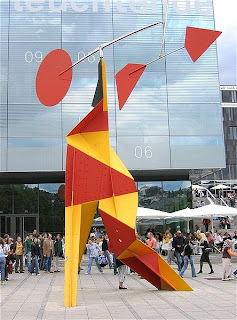The expression Kinetic Art was used from the mid-1950s onward. It referred to an international trend followed by artists such as Soto, Takis, Agam and Schoffer. Some Kinetic artists also worked in the field of Op Art. Their works were influenced by a modernist aesthetic and could be made with contemporary materials (e.g., aluminum, plastic, neon). Most kinetic works were moving geometric compositions. In Italy artists belonging to Gruppo N, founded in Padua in 1959 (including Biasi, Costa and Massironi, among others), carried out experiments with light, projections and reflections associated with movement.
The members of the French group GRAV, which included Le Parc, Morellet and Sobrino and was established in 1960's in Paris, created optical and kinetic environments that disturbed and interfered with meanings and relations to space.
The term kineticism broadened the concept of Kinetic Art to all artistic works involving movement, without any reference to a specific aesthetics. It applies to all those artists today who work with any kind of movement, rather than only geometric art.
Artist => Alexander Calder
Alexander Calder (July 22, 1898 – November 11, 1976) was an American sculptor and artist most famous for inventing abstract sculptures he called "mobiles". In addition to mobile and "stabile" sculpture, Alexander Calder also created paintings, lithographs, toys, tapestry, jewelry and household objects.

Hiç yorum yok:
Yorum Gönder